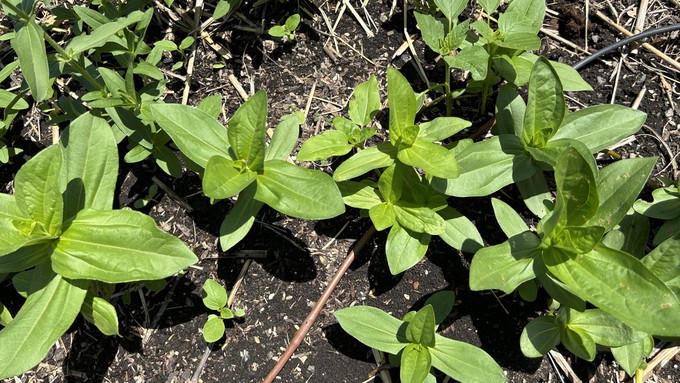
With more coolish weather ahead, there's still time to plant for summer

It's the perfect time to plant zinnia transplants or start some from seed -- this bed contains both. Zinnias love heat and are great cutting flowers. They'll bloom through September. Kathy Morrison
Our taste of summer was just that – a taste. After a weekend in the 90s, we’re slipping back into mild spring weather with several days in the low 80s – maybe even the 70s.
According to the National Weather Service, cloudy and breezy conditions will put a cap on our early June heat wave and keep daytime temperatures unusually cool, following a trend we’ve seen all spring. The forecast high for Tuesday in Sacramento is only 78 degrees – 10 below average for early June. While our afternoons may feel a little chilly, our overnight lows will remain warm – staying above 56 degrees, which is our average low for June.
The result: Warm soil and comfortable days – wonderful conditions for planting and growing. It’s not too late to set out tomato and pepper seedlings as well as squash and melon plants. They’ll appreciate this not-too-hot weather. Just remember to water.
* From seed, plant corn, pumpkins, radishes, melons, squash and sunflowers.
* Plant basil to go with your tomatoes.
* Transplant summer annuals such as petunias, marigolds and zinnias.
* It’s also a good time to transplant perennial flowers including astilbe, columbine, coneflowers, coreopsis, dahlias, rudbeckia, salvia and verbena.
* Let the grass grow longer. Set the mower blades high to reduce stress on your lawn during summer heat. To cut down on evaporation, water your lawn deeply during the wee hours of the morning, between 2 and 8 a.m.
* Tie up vines and stake tall plants such as gladiolus and lilies. That gives their heavy flowers some support.
* Dig and divide crowded bulbs after the tops have died down.
* Give summer flowers a slow-release fertilizer.
* Mulch, mulch, mulch! This “blanket” keeps moisture in the soil longer and helps your plants cope during hot weather.
* Thin grapes on the vine for bigger, better clusters later this summer.
* Cut back fruit-bearing canes on berries.
* Feed camellias, azaleas and other acid-loving plants.
* Trim off dead flowers from rose bushes to keep them blooming through the summer. Roses also benefit from deep watering and feeding now. A top dressing of aged compost will keep them happy. It feeds as well as keeps roots moist.
* Pinch back chrysanthemums for bushier plants with many more flowers in September.
Comments
0 comments have been posted.Sacramento Digs Gardening to your inbox.
Sites We Like
Garden Checklist for week of July 21
Your garden needs you!
* Keep your vegetable garden watered, mulched and weeded. Water before 8 a.m. to reduce the chance of fungal infection and to conserve moisture.
* Feed vegetable plants bone meal, rock phosphate or other fertilizers high in phosphate to stimulate more blooms and fruiting. (But wait until daily high temperatures drop out of the 100s.)
* Don’t let tomatoes wilt or dry out completely. Give tomatoes a deep watering two to three times a week.
* Harvest vegetables promptly to encourage plants to produce more. Squash especially tends to grow rapidly in hot weather. Keep an eye on zucchini.
* Pinch back chrysanthemums for bushy plants and more flowers in September.
* Remove spent flowers from roses, daylilies and other bloomers as they finish flowering.
* Pinch off blooms from basil so the plant will grow more leaves.
* Cut back lavender after flowering to promote a second bloom.
* It's not too late to add a splash of color. Plant petunias, snapdragons, zinnias and marigolds.
* From seed, plant corn, pumpkins, radishes, winter squash and sunflowers.